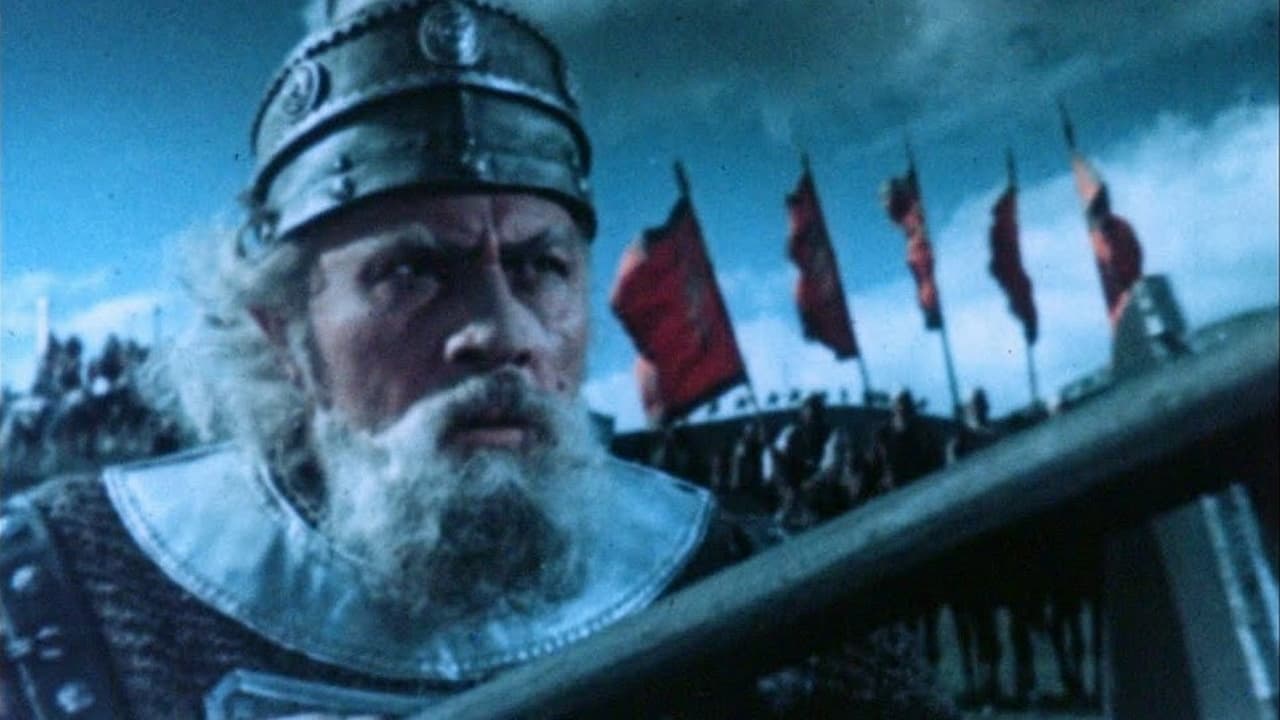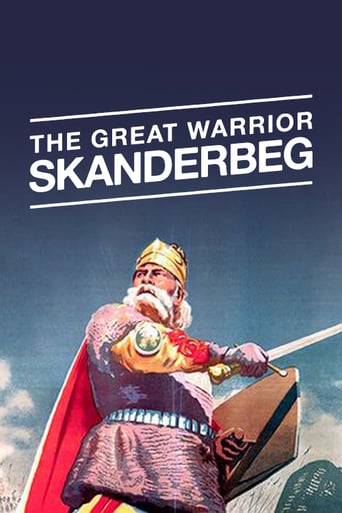

I don't usually write reviews, but I don't feel like "The Great Warrior Skanderbeg" has gotten what it deserves here. It's one of those rare movies where my immediate response upon finishing it was just, "Damn..." Even upon beginning the film, the overall feel may remind some viewers of such more well-known historical epics such as "Ben-Hur" and "Spartacus". The battle scenes in particular remind me of such films, and are extremely well done. In addition, the dance scenes (which aren't always 100% necessary but still nice nonetheless) are beautifully choreographed, and the costumes that go along with them equally stunning. Without spoiling anything, I'll say the final scene was what really blew me away, and served as a nice wrap-up to the story, which spans nearly 60 years from Gjergj Kastriot's childhood to the year of his death.There are a few problems with this film, however. Some of the major complaints I've seen have been about some of the acting, dialogue, and one-dimensional characters. Additionally, I should note that the educated viewer will be able to read between the lines and see traces of the Hoxhaist ideology this film was made under, but not at all to a distracting extent (like, for example, the films of North Korea). In my opinion, none of these things really took away from the film's strengths.Last time I checked, there are numerous versions of this film available online, making it fairly easily accessible, but even if you are unable to find it, I'd still recommend putting in the effort to hunt it down if you're a fan of 50s/60s historical epics and/or the cinema of the Eastern bloc.
... View Morei already watch this movie more than three times and every time i watch it in the end i was always thinking the same thing wow this movie is fantastic i like this true history like the middle age war and the strategy that is used in this period of time is fantastic Albania is proud to have soldier like Gjergj Kastrioti and plenty plenty great soldier and bed thing about it is because movie is too old and need a remake to be even better to know this generation what a great warrior use to be Gjergj Kastriot a.k.a Skenderbeg, glad to watch this movie from 1953 such a grateful and strong history from great name and soldier it will be even better if we see soon the new movie with the same history
... View MoreThis movie i saw as kid in Albania many years ago and still it make me spell bound with its fabulous dance moments which are amazing knowing this is a 1953 production so much better that today Bollywood crap. Skanderbeg was a hero of Albania and Mel Gibson should do a new version of this movie which will make William Walace(BraveHeart)LOOK LIKE A CHICKEN FARMER IN Scotland. In today day and age having an Albanian 1953 color picture is a true blessing.Yes the acting may seem and look bit outdated and wooden but the fact remain that Russian touch has helped Skanderbek shine and for my liking this is a CLASSIC... Here is some historical facts about George Kastrioti nicknamed in honor of Alexander The Great Skander and title Beg. Gjergj (Albanian: George) Kastrioti was born in Kruja from Gjon Kastrioti, lord of Middle Albania, who was obliged by the Ottomans to pay tribute to the Empire. To assure the fidelity of local rulers the Sultan used to take their sons as hostage and bring them up in his court. Gjergj Kastrioti attended military school in the Ottoman Empire and was named Iskander Bey which in Turkish means Lord Alexandre. He was distinguished as one of the best officers in several Ottoman campaigns both in Asia Minor and in Europe, and the Sultan appointed him General. He even fought against Greeks, Serbs and Hungarians, and some sources says that he used to maintain secret links with Raguse, Venice, Vladislas of Hungary et Alphonse V of Naples. Sultan Murat II gave him the title Vali which made him the General Governor of some provinces in central Albania. He was respected everywhere but he missed his country. In 1443, during the battle against the Hungarians of Hunyadi in Nish (in present day Serbia), he abandoned the Ottoman Army and captured Kruja, his father's seat in middle Albania. Above the castle he rose the Albanian flag, a red flag with the black double-headed eagle, the present-day Albanian flag, and pronounced to his countrymen the famous words: "I have not brought you liberty, I found it here, among you". He managed to unite all Albanian princes at the town of Lezha (League of Lezha, 1444) and united them under his command to fight against the Turks. During the next 25 years he fought, with forces rarely exceeding 20,000 against the most powerful army of that time and defeated it for 25 years. In 1450 the Turkish army was led by the Sultan Murad II in person, who died after his defeat in the way back. Two other times, in 1466 and 1467, Mehmed II, the conqueror of Constantinople, led the Turkish army himself against Skenderbeg and failed too. The Ottoman Empire attempted to conquer Kruja 24 times and failed all 24 of them. Skenderbeg's military successes evoked a good deal of interest and admiration of the Papal state, Venice and Naples, themselves threatened by the growing Ottoman power across the Adriatic. The Albanian warrior played his hand with a good deal of political and diplomatic skill in his dealings with the three Italian states. Hoping to strengthen and expand the last Christian bridgehead in the Balkans, they provided Skenderbeg with money, supplies and occasionally with troops. One of his most powerful and consistent supporters was Alfonso the Magnanimous (1416-1458), the Aragone king of Naples, who decided to take Skenderbeg under his protection as vassal in 1451, shortly after the latter had scored his second victory against Murad II. In addition to financial assistance, the King of Naples undertook to supply the Albanian leader with troops, military equipment as well as with sanctuary for himself and his family if such a need should arise.As an active defender of the Christian cause in the Balkans, Skenderbeg was also closely involved with the politics of four Popes, one of them being Pius II (1458-1464) or Aeneas Sylvius Piccolomini, the Renaissance humanist, writer and diplomat. Profoundly shaken by the fall of Constantinople in 1453, Pius II tried to organise a new crusade against the Turks; consequently he did his best to come to Skenderbeg's aid, as two of his predecessors Nicholas V and Calixtus III, had done before him. This policy was continued by his successor, Paul II,(1464-1473).They gave him the title Athleta Christi. For a quarter of a century he and his country prevented Turks from invading Catholic Western Europe. After his death from natural causes in 1468 in Lezha, his soldiers resisted the Turks for the next 12 years. In 1480 Albania was finally conquered by the Ottoman Empire. When the Turks found the grave of Skenderbeg in Saint Nicholas church of Lezha, they opened it and held his bones like talismans for luck. In 1480 the Turks invaded Italy and conquered the City of Otranto. Skenderbeg's posthumous renown was by no means confined to his own country. Voltaire thought the Byzantine Empire would have survived had it possessed a leader of his quality. A number of poets and composers have also drawn inspiration from his military career. The French sixteenth-century poet Ronsard wrote a poem about him and so did the nineteenth-century American poet Longfellow. Antonio Vivaldi, too, composed an opera entitled Scanderbeg.Skenderbeg today is the National Hero of Albania. Many museums and monuments are raised in his honour around Albania, and among them the Museum of Skenderbeg in his famous castle in Kruja. Bibliography: Noli, Fan S.: George Castrioti Scanderbeg, New York, 1947 Logoreci, Anton: The Albanians, London, 1977
... View MoreThe movie tells about the legendary almost mythical exploits of George Castriot Scanderbeg against one of the most ruthless and greatest empires of the world, the Ottoman Empire. I gave this movie a 7 however because it does not portray Scanderbeg's true image. He was not a mountain dweller rather he was a Prince of very noble blood, and it said in the chronichles of the Musachi Princes and in the biography of Jacques Lavardine that Scanderbeg's family could trace back it's roots up to 30 generations, and that they were directly tied to the legendary Phyrrus King of Epirus descendant of the Achilles the Epirotan, and from there stems the powerful race of the Epirotans a semi pelasgian-illyrian tribe. This background is not in the movie, partly because those information came only in the last 20 years, which makes me wonder when will Hollywood write a script about the true story of what can be called the last warrior king and erudite in the same fashion as the Arthurian legends(only this one we know for sure to be real) and many other valorous comandants of the history of mankind.We had Troy, Alexander and even Hercules, now it's time to write about the great Scanderbeg and how he saved Europe from the Ottoman threat by fighting with them alone(with minor support from the Pope) for more then 25 years.This is a must see movie, I don't know if they have managed to put subscripts, but the music is certainly amazing, and considering hat this was done with the help of the russians because albania was too poor to afford such a movie I think that overall for the time, for the knowledge we had about Scanderbeg, or I should say the widespread common knowledge that we had about him, this is truly a remarkable movie with it's artistic elements.The guy who plays Scanderbeg is also the best match they could find. I'm sure the counterpart of him would be Russell Crow today.
... View More